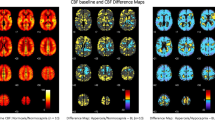Abstract
We assessed the local cerebral blood flow (LCBF) in 40 patients under fentanyl-diazepam anesthesia. The measurement of LCBF was made using 50%–70% stable xenon with 20 min of inhalation interval and a shuttle method for computed tomography imaging. All patients were anesthetized with 5.95±1.76 μg·kg−1 fentanyl and 0.22±0.07 mg·kg−1 diazepam under mechanical ventilation during CBF measurement. The values and distribution of LCBF on non-affected hemisphere appeared to be unaltered by fentanyldiazepam anesthesia. We also assessed the cerebral carbon dioxide reactivity in 6 patients. The cerebral carbon dioxide reactivity, expressed as percentage change in LCBF per unit change in arterial carbon dioxide partial pressure, was 5.39±1.07, and there were no significant differences of reactivity among regions studied. In conclusion, we showed reference values of LCBF and carbon dioxide reactivity, measured by stable xenon-enhanced computed tomography, in patients under fentanyl-diazepam anesthesia. Carbon dioxide reactivity was preserved in all regions including gray matter, white matter, and basal ganglia.
Similar content being viewed by others
References
Johnson DW, Stringer WA, Marks MP, et al. (1991) Stable xenon CT cerebral blood flow imaging: Rationale for and role in clinical decision making. AJNR 12:201–213
Meyer JS, Hayman LA, Yamamoto M, et al. (1980) Local cerebral blood flow measured by CT after stable xenon inhalation. AJR 135:239–251
Yonas H, Good WF, Gur D, et al. (1984) Mapping cerebral blood flow by xenon-enhanced computed tomography: Clinical experience. Radio 152:435–442
Yonas H, Gur D, Latchaw RE, et al. (1987) Xenon computed tomography blood flow mapping. In: Wood JH (ed) Cerebral blood flow, physiologic and clinical aspects. McGraw-Hill, New York, pp 220–242
Meyer JS, Hayman LA, Amano T, et al. (1981) Mapping local blood flow of human brain by CT scanning during stable xenon inhalation. Stroke 12:426–436
Vernhiet J, Renou AM, Orgogozo JM, et al. (1978) Effects of diazepam-fentanyl mixture on cerebral blood flow and oxygen consumption in man. Br J Anaesth 50:165–169
Kuriyama Y, Sawada T, Karasawa J, et al. (1985) The mapping image of local cerebral blood flow by use of stable xenon and CT. Neurosurgeons 4:153–165
Gur D, Yonas H, Jackson DL, et al. (1985) Simultaneous measurements of cerebral blood flow by the xenon/CT method and the microsphere method: A comparison. Invest Radiol 20:672–677
Haughton VM, Donesan JF, Walsh PR, et al. (1980) A clinical evaluation of xenon enhancement for computed tomography. Invest Radiol 15[Suppl VI]:S160-S163
Obrist WD, Jaggi JL, Harel D, et al. (1985) Effect of stable xenon inhalation on human CBF. J Cereb Blood Flow Metab 5:S557-S558
Panos PP, Fatouros R, Kishore PRS, et al. (1985) Comparison of improved stable xenon/CT method for cerebral blood flow measurements with radiolabeled microspheres technique. Radiology 158:334
Giller CA, Purdy P, Lindstrom (1990) Effects of inhaled stable xenon on cerebral blood flow velocity. AJNR 11:177–182
Nilsson E, Ingvar DH (1965) Cerebral blood flow during neurolept-analgesia in the cat. Acta Anaesthesiol Scand 10:47–54
Freeman J, Ingver DH (1967) Effects of fentanyl on cerebral cortical blood flow and EEG in the cat. Acta Anaesthesiol Scand 11:381–391
Michenfelder JD, Theye RA, (1971) Effects of fentanyl, droperidol, and innovar on canine cerebral metabolism and blood flow. Br J Anaesth 43:630–636
Cold GE, Christense KJS, Nordentoft J, et al. (1988) Cerebral blood flow, cerebral metabolic rate of oxygen and relative CO2 reactivity during neurolept-anesthesia in patients subjected to craniotomy for supratentorial cerebral tumors. Acta Anaesthesiol Scand 32:310–315
Knundsen L, Cold GE, Jensen S, et al. (1989) Cerebral blood flow (CBF) and metabolism (CMRO2) during midazolam infusion. Interaction with nitrous oxide, and reversal with flumazenil in patients subjected to craniotomy for supratentorial cerebral tumors. Acta Anaesthesiol Scand [Suppl] 33:142
Karasawa J, Touho H, Shishido H, (1992) Simplified method for mapping local cerebral blood flow. In: Yonas H (ed) Cerebral blood flow measurement with stable xenon-enhanced computed tomography. Raven, New York, pp 71–76
McPherson RW, Traystman RJ (1984) Fentanyl and cerebral vascular responsivity in dogs. Anesthesiology 60:180–186
Kawaguchi M, Furuya H, Kurehara K, et al. (1991) Effects of nicardipine on cerebral vascular responses to hypocapnia and blood flow velocity in the middle cerebral artery. Stroke 22:1170–1172
Harper AM, Bell RA (1963) The effect of metabolic acidosis and alkalosis on the blood flow through the cerebral cortex. J Neurol Neurosurg Psychiat 26:341–344
Author information
Authors and Affiliations
About this article
Cite this article
Kawaguchi, M., Kuro, M., Ohsumi, H. et al. Local cerebral blood flow measured by stable xenon CT during fentanyl-diazepam anesthesia. J Anesth 8, 60–63 (1994). https://doi.org/10.1007/BF02482757
Received:
Accepted:
Issue Date:
DOI: https://doi.org/10.1007/BF02482757




